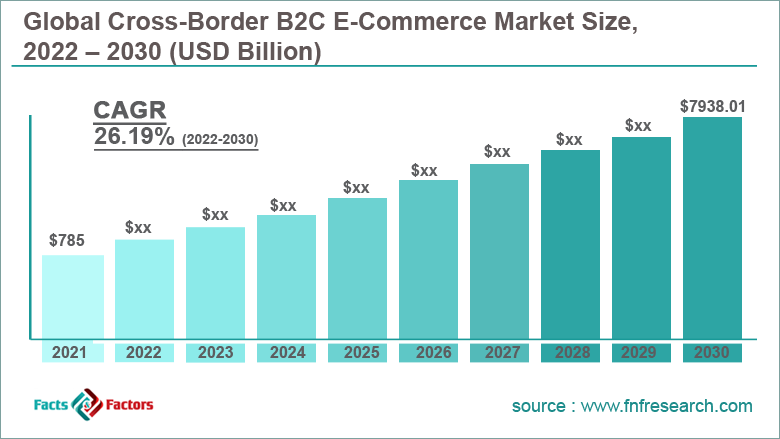Search Market Research Report
Cross-Border B2C E-Commerce Market Size, Share Global Analysis Report, 2022 – 2030

Cross-Border B2C E-Commerce Market Size, Share, Growth Analysis Report By Category (Personal Care & Beauty, Apparel & Accessories, Health & Nutrition, Entertainment & Education, Food & Beverages, and Others), By Offering (In-House Brands and Assorted Brands), By End-User (Teenagers, Adults, and Senior Citizens), By Mode of Payment (Digital Wallets, Internet Banking, Credit & Debit Cards, Unified Payments Interface (UPI), and Others), and By Region - Global and Regional Industry Insights, Overview, Comprehensive Analysis, Trends, Statistical Research, Market Intelligence, Historical Data and Forecast 2022 – 2030
Industry Insights
[240+ Pages Report] According to the report published by Facts and Factors, the global cross-border B2C e-commerce market size was worth around USD 785 billion in 2021 and is predicted to grow to around USD 7938.01 billion by 2030 with a compound annual growth rate (CAGR) of roughly 26.19% between 2022 and 2030. The report analyzes the global cross-border B2C e-commerce market drivers, restraints/challenges, and the effect they have on the demands during the projection period. In addition, the report explores emerging opportunities in the cross-border B2C e-commerce market.

 Market Overview
Market Overview
A cross-border transaction of goods, services, or information refers to the sending and receiving of the items in question across legislative areas or boundaries in compliance with the regulatory laws of the regions involved in the transaction. Cross-border B2C e-commerce is the buying and selling of products or services across geographical locations directly from the business to the customer without the need for a middleman using digital technology like applications, websites, or social media.
Cross-border transactions allow businesses to cater to a larger consumer group and at the same time the users benefit by having access to more options and quality products that can be purchased without any hassle of requiring a third party to carry out the deal. Over the years, the global market has registered significant growth due to multiple factors because of the advantages offered by the segments it is associated with.
 Key Insights
Key Insights
- As per the analysis shared by our research analyst, the global cross-border B2C e-commerce market is estimated to grow annually at a CAGR of around 26.19% over the forecast period (2022-2030)
- In terms of revenue, the global cross-border B2C e-commerce market size was valued at around USD 785 billion in 2021 and is projected to reach USD 7938.01 billion, by 2030.
- The market is projected to grow at a significant rate due to the growing investments in e-commerce
- Based on category segmentation, apparel & accessories were predicted to show maximum market share in the year 2021
- Based on mode of payment segmentation, credit & debit cards was the leading mode in 2021
- On the basis of region, Asia-Pacific was the leading revenue generator in 2021

 Growth Drivers
Growth Drivers
- Growing investments in e-commerce to propel market demand
The global cross-border B2C e-commerce market is projected to grow due to the rise in investments in e-commerce business from private as well as public sector companies. E-commerce has managed to change the people who make purchases while ensuring product quality and seamless user experience. E-commerce has also generated mass employment opportunities across job roles including information technology (IT) professionals and non-IT professionals.
Using the e-commerce model for selling or buying products has helped in speeding up the transaction process, it also reduces miscellaneous costs incurred by buyers and sellers alike, consumers have all the necessary data available at their disposal for price or product comparison which helps them in making informed choices. The main reason propelling the growth of cross-border e-commerce businesses is the lack of reach limitation. The model opens new growth horizons for the market players as they can sell their products from one corner of the world to another in a matter of a few days, which is something that physical purchases cannot provide.
 Restraints
Restraints
- Complications with shipping to restrict market expansion
One of the major concerns that players in the cross-border e-commerce segment face is the serious complications that come along with the shipping aspect of the order. When products are bought or sold within a country, tax and other laws remain the same from the moment the purchase is made until it is delivered to the buyer. However, in cross-border transactions, the laws or regulations tend to change since every country has its own export and import laws. This could setback a large section of the revenue that could be generated.
 Opportunities
Opportunities
- Changing consumer preference to provide growth opportunities
With internet accessibility, there has been significant growth in the awareness rate amongst the population about brands and different types of products one can purchase which may not be available in the regional market. This has created a general increase in the demand for such exclusive products and companies, the segment of people who prefer international products over domestic items. This is driving the growing entry of multinational companies in remote regions. For instance, Shein, a Chinese fast fashion retailer, generates its highest regional revenue from the US market.
 Challenges
Challenges
- Managing sales fraud to challenge the market expansion
A major challenge that most of the global cross-border B2C e-commerce market players face is related to the growing concern over the rising number of payment frauds occurring in online transactions, this is mostly observed in people using a credit card for purchases or opting for cash on delivery where buyers may refuse to accept the product. To curb credit card-related fraud, companies use address verification systems but it is not a full-proof plan against the sharp practice. The same is applicable to fake sellers on websites that cater to assorted brands.
 Segmentation Analysis
Segmentation Analysis
The global cross-border B2C e-commerce market is segmented based on category, offering, end-user, mode of payment, and region.
The global market registered the highest growth in the apparel & accessories segment due to the growing demand and consumption of fast fashion, which is a term used to describe the process of rapid changes in clothing lines in a short duration. Most fast fashion clothing products are relatively less priced as compared to slow fashion, which makes them highly attractive to the younger population. Fast fashion chains have adopted exhaustive marketing strategies to reach a larger consumer database. Shein.com amassed revenue of USD 13345 million in 2021.
The global market growth was propelled by the credit & debit card segment in 2021 because it is the most trusted and well-accepted method of payment in terms of cross-border transactions. Credit cards are most widely used as compared to debit cards because they are highly prone to fraudulent events. Many credit card companies offer their clients protection against fraud and purchase giving them a certain degree of security. India recorded around INR 8.9 lakh crore of credit card transactions in 2021 as per the Economic Times.
 Recent Developments:
Recent Developments:
- In October 2022, Indian beauty retailer Nykaa and beauty entrepreneur Charlotte Tilbury entered a partnership aimed at launching the latter’s world-renowned beauty brand called Charlotte Tilbury Beauty for the Indian market. In the same year, two-thirds of the beauty brand’s global revenue was from online sales
- In September 2021, Urbanic, a London-based e-commerce brand, recorded strong sales value upon its launch in the Indian market through the e-commerce portal called Myntra. On its first day of launch, Urbanic was the second-highest sales-generating brand on the portal
 Report Scope
Report Scope
Report Attribute |
Details |
Market Size in 2021 |
USD 785 Billion |
Projected Market Size in 2030 |
USD 7938.01 Billion |
CAGR Growth Rate |
26.19% CAGR |
Base Year |
2021 |
Forecast Years |
2022-2030 |
Key Market Players |
JD.com (JingDong), Shein, Alibaba Group, Anchanto, BoxMe, DHL Group, Fruugo, Joom, Pinduoduo, PayPal., and others. |
Key Segment |
By Category, Offering, End-User, Mode of Payment, and Region |
Major Regions Covered |
North America, Europe, Asia Pacific, Latin America, and the Middle East &, Africa |
Purchase Options |
Request customized purchase options to meet your research needs. Explore purchase options |
 Regional Analysis
Regional Analysis
- Asia-Pacific to register the highest growth
The global cross-border B2C e-commerce market is projected to register the highest growth in Asia-Pacific during the projection period owing to the growing demand for international products in the countries of India, China, Japan, and South Korea. China is home to one of the largest fast-fashion chains of retailers Shein which currently is one of the largest revenue-generating brands in its segment. Alibaba, another Chinese e-commerce platform, with an active user count of 903 million users as of the first quarter of 2022.
The regional economies are registering an influx for entry of foreign brands since the demand for the products has increased multifold due to changing consumer lifestyles, rise in disposable income, and growing awareness. As per the Indian Brand Equity Foundation, the country's e-commerce industry is expected to reach a value of USD 350 billion by 2030. Growth in Europe may be driven by the growing strategic measures of the regional players to enter new markets.
 Competitive Analysis
Competitive Analysis
- JD.com (JingDong)
- Shein
- Alibaba Group
- Anchanto
- BoxMe
- DHL Group
- Fruugo
- Joom
- Pinduoduo
- PayPal.
The global cross-border B2C e-commerce market is segmented as follows:
 By Category Segment Analysis
By Category Segment Analysis
- Personal Care & Beauty
- Apparel & Accessories
- Health & Nutrition
- Entertainment & Education
- Food & Beverages
- Others
 By Offering Segment Analysis
By Offering Segment Analysis
- In-House Brands
- Assorted Brands
 By End-User Segment Analysis
By End-User Segment Analysis
- Teenagers
- Adults
- Senior Citizens
 By Mode of Payment Segment Analysis
By Mode of Payment Segment Analysis
- Digital Wallets
- Internet Banking
- Credit & Debit Cards
- Unified Payments Interface (UPI)
- Others
 By Regional Segment Analysis
By Regional Segment Analysis
- North America
- The U.S.
- Canada
- Mexico
- Europe
- France
- The UK
- Spain
- Germany
- Italy
- Nordic Countries
- Denmark
- Sweden
- Norway
- Benelux Union
- Belgium
- The Netherlands
- Luxembourg
- Rest of Europe
- Asia Pacific
- China
- Japan
- India
- Australia
- South Korea
- Southeast Asia
- Indonesia
- Thailand
- Malaysia
- Singapore
- Rest of Southeast Asia
- Rest of Asia Pacific
- The Middle East & Africa
- Saudi Arabia
- UAE
- Egypt
- South Africa
- Rest of the Middle East & Africa
- Latin America
- Brazil
- Argentina
- Rest of Latin America
Industry Major Market Players
- JD.com (JingDong)
- Shein
- Alibaba Group
- Anchanto
- BoxMe
- DHL Group
- Fruugo
- Joom
- Pinduoduo
- PayPal.
Frequently Asked Questions

Copyright © 2024 - 2025, All Rights Reserved, Facts and Factors


